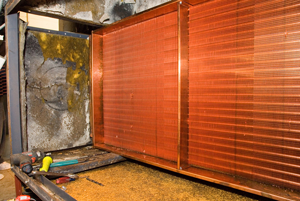Research effort supported by funds from U.S. Department of Defense
July 23, 2009

Bright new copper heat exchanger
ready to cool troops at Fort Jackson
If you turn on your car air conditioner on a hot summer day and are overwhelmed by the stench of mildew, it is because mold is growing in the air conditioner unit. The same thing happens on a larger scale in the heating and air conditioning (HVAC) units of buildings.
HVAC units provide dark, moist environments - perfect breeding grounds for disease-carrying bacteria, viruses, and molds that also produce odors and decreased efficiency.
To combat this phenomenon, the U.S. Department of Defense is funding research into antimicrobial copper components that can control the growth of organisms that grow in HVAC units. The units are installed at a barracks at Fort Jackson in Columbia.
Dr. Charles Feigley, an environmental health sciences professor at the Arnold School of Public Health, and principal investigator for the study, explained the need for this research, "Improvements in building and construction methods have generally led to increased energy efficiency, but at the same time, these 'tighter' building envelopes tend to trap bacteria and mold, leading to odors. The results of this real-world trial should encourage advancements in the design of HVAC systems."
To test copper's antimicrobial qualities in HVAC systems, the researchers have ordered custom-built equipment with copper condensing coils, fins, and drip pans and identical systems with conventional aluminum components.
The new HVAC systems have been installed in identical Army barracks. One barracks will be heated and cooled by a system with aluminum components; the other barracks will have a copper-component-only system.
Air quality in the barracks was tested prior to the installation of the new systems. The tests will be repeated in several months to see which barracks has better air quality.
Lab tests have shown that copper and copper alloys can eradicate pathogenic bacteria within 90 minutes at room temperature and within several hours at chilled air temperatures.
Copper ions are thought to overwhelm and compromise the integrity of a bacterium's cell membrane and effectively suffocate the cell or cause irreparable oxidative damage.
In addition to being antimicrobial, the copper elements are highly recyclable and are better thermal conductors than their aluminum counterparts.
In conjunction with the field trial at Fort Jackson, Feigley and Dr. Jamil Khan, Chair of Mechanical Engineering, are conducting a laboratory study at the Arnold School’s Department of Environmental Health Sciences where small HVAC systems with copper and aluminum components will be tested side by side.
The researchers will feed gas steams containing identical amounts of dust and microbes into each system, then check the components and the air in each test chamber for the presence of pathogens.
The copper study is a signature research topic for Feigley whose career has been devoted to evaluating and controlling human exposure to hazardous environmental agents.
His teaching and research are focused on industrial hygiene, indoor air pollution and exposure assessment.
This project is supported by the U.S. Army Medical Research and Materiel Command under Contract No. W81XWH-07-C-0054. Any opinions, findings, and conclusions or recommendations expressed in this material are those of the authors and do not necessarily reflect the views of the U.S. Army Medical Research Acquisition Activity.



_01.jpg)
_02.jpg)